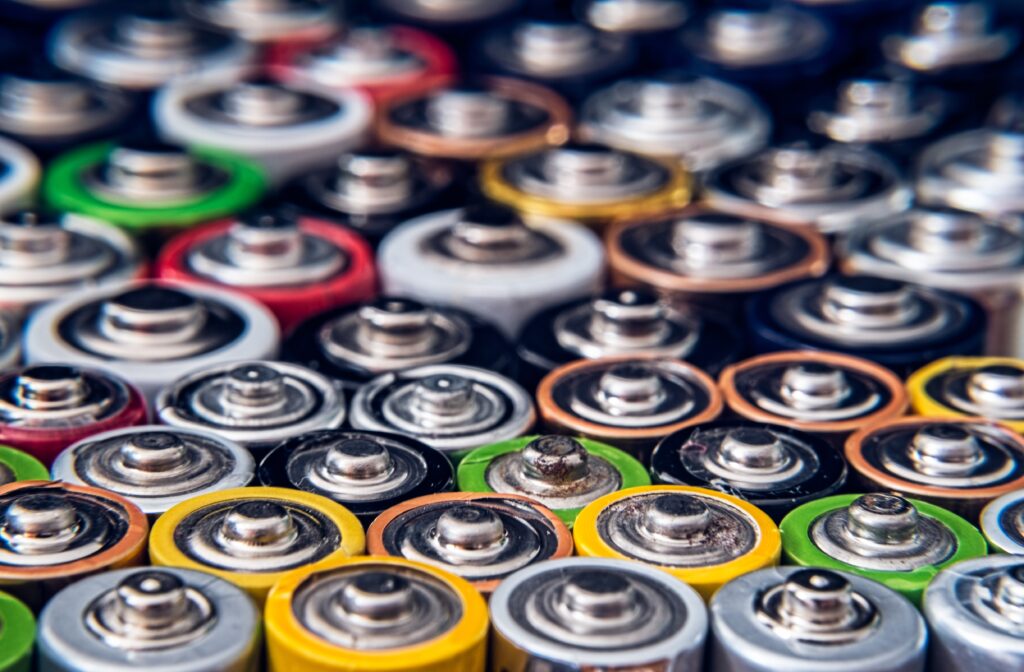Why do solar lights have batteries? Because solar panels produce electricity but they don’t store it. The batteries let the solar lights system collect energy by day, and then use it by night.
That, in a nutshell, is why solar lights have batteries.
But there is more to know. The batteries have a major impact on the performance of a solar light, so here are some other questions to consider.
- Can I use standard alkaline batteries in a solar light?
- What kind of batteries do solar lights use?
- Can I replace the batteries in my solar lights?
- How to replace solar light batteries
- Are Ni-MH and NiCd batteries interchangeable?
- Storage capacity of rechargeable batteries
- Do solar lights come with batteries?
- Conclusion: Why do solar lights have batteries?

Can I use standard alkaline batteries in a solar light?
Well, they will turn the light on, but if you leave them in for long you will almost certainly damage the solar light. For more details, check out our article, “Can you use regular batteries in solar lights.”
What kind of batteries do solar lights use?
Virtually all solar lights for home or garden will use one of the following three battery types: Ni-MH (nickel-metal hydride), NiCd (nickel cadmium), or Li-ion (lithium ion).
Lithium ion batteries tend to have larger storage capacity and are the dominant battery technology in larger, brighter lights such as solar security lights or solar street lights.
Ni-MH and NiCd are interchangeable, but Ni-MH is becoming the more popular choice because their chemistry makes them more environmentally friendly. They are also less prone to the memory effect. Both Ni-MH and NiCd batteries come in standard AA or AAA size.
For a deeper dive into the memory effect and other aspects of rechargeable batteries for solar lights, see our article, “Do you need special batteries for solar lights?“
Can I replace the batteries in my solar lights?
Yes, you can, and eventually you’ll need to.
Rechargeable batteries can only recharge so many times. This is referred to as the cycle life of the battery. For optimal performance you should be replacing the batteries every 1.5 to 2 years.
You can stretch it beyond that if you’re willing to accept a drop in performance. (I have a string of solar fairy lights decorating a bush in my front yard. The batteries are about four years old and they still power the lights for about 3 to 4 hours each night.)
How to replace solar light batteries
Step 1: Find out what size battery you need. When I say “size”, I mean the physical size of the battery, not the storage capacity (see below).
Simply open the battery compartment of your solar lights and see what’s currently in there. Now be sure to replace those batteries with something of the same size.
If the batteries are Ni-MH (nickel metal hydride) or NiCd (nickel cadmium) then the size will be either AA or AAA. If the batteries are lithium-ion, these are not sold in the AA or AAA size and you’ll simply need to purchase a replacement of the same size as whatever you find currently in use.
Are Ni-MH and NiCd batteries interchangeable?
Yes, they are. Both come in AA and AAA size and they are completely interchangeable. That said, we recommend Ni-MH because they are much more environmentally friendly.
Storage capacity of rechargeable batteries
Have a look at the battery currently installed and search for the mAh rating.
You’re looking for a number like 400 mAh or 1000 mAh or 2000 mAh. This tells you the storage capacity of the battery.
The bigger the number, the larger the storage capacity of the battery and the longer your lights will last, assuming the battery receives a full charge.
When replacing the batteries, it’s best to install batteries with roughly the same mAh rating as what the manufacturer provided.
You can install batteries with a higher mAh rating and this will extend the service hours of a single charge.
But don’t overdo it. If the manufacturer chose to equip the lights with a 1000 mAh battery, then that is probably a good match for the energy generating capacity of the solar panels.
In other words, you could replace it with a 2000 mAh battery, but the solar panels would probably struggle to charge it completely. It would be like installing a massive gas tank in your car only to find that the gas station sets a limit of 10 gallons per fill up.
Do solar lights come with batteries?
Yes, and just about every manufacturer will list the type of battery on the product info page at Amazon or other retailer.
Conclusion: Why do solar lights have batteries?
Without batteries, the electricity produced by the solar panel would have to be used immediately, or lost forever.
The batteries are key part of a solar light and will have a major influence on the performance of the lights.
For a deep and more technical dive into the differences between Ni-MH, NiCd and Li-ion batteries check out this article from BatteryUniversity.com.
